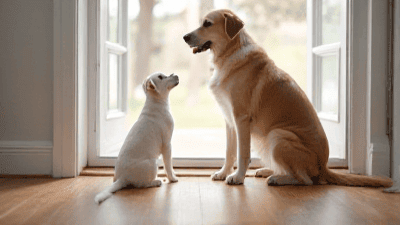
Dogs are known as man's best friend for good reason. They are loyal companions, loving pets, and excellent members of our families. However, understanding what your dog is trying to communicate can sometimes be a challenge. Dogs communicate primarily through body language, and deciphering their signals can significantly enhance your relationship with them.
The Importance of Understanding Dog Body Language
Understanding your dog's body language is essential for several reasons:
-
Improves Safety: Recognizing signs of aggression or fear can prevent dangerous situations for both your dog and others. Proper interpretation of body language can help you de-escalate tense situations.
-
Strengthens Bonding: A deeper understanding of your dog's emotions and needs fosters a stronger bond between you and your pet, leading to a happier and healthier relationship.
-
Enhances Training: Understanding body language cues can improve training outcomes. When you recognize when your dog is receptive or stressed, you can adjust your training methods accordingly.
-
Facilitates Communication: Dogs rely on body language to express their feelings. Learning to interpret these signals helps you respond effectively to your dog's needs.
Key Elements of Dog Body Language
Dogs communicate through various body parts, including their tails, ears, eyes, mouths, and posture. Let's take an in-depth look at these elements and what they can tell us about your dog’s emotional state.
1. Tail Position and Movement
The tail is one of the most expressive parts of a dog’s body. Its position and movement can convey a wide range of emotions.
-
Wagging Tail: A tail that is wagging vigorously often indicates excitement or happiness. However, the direction of the wag can carry different meanings. A wagging tail to the right may suggest a positive emotional state, while a wagging tail to the left may indicate anxiety or uncertainty.
-
Low Tail: A tail held low can indicate submission, fear, or insecurity. If your dog approaches with a lowered tail, it may be feeling timid or unsure.
-
Tucked Tail: A tail tucked between the legs typically signifies fear or submission. If you notice this behavior, it is essential to create a calm and safe environment for your dog.
-
Stiff Tail: A rigid, high-held tail often indicates alertness or excitement. This can be a sign that your dog is on high alert, perhaps signaling danger or something intriguing in the environment.
2. Ear Position
Just like tail movements, the position of a dog's ears can provide valuable insight into their emotional state.
-
Erect Ears: Ears that are upright and facing forward often indicate that your dog is alert, interested, or engaged. They are ready to listen and respond.
-
Relaxed Ears: Ears that are hanging loosely alongside the head generally indicate a relaxed and content dog.
-
Backward Ears: If a dog’s ears are pinned back against its head, it can signify fear, submission, or apprehension. It’s essential to monitor other body language cues when you see this expression.
-
Flopping Ears: Dogs with floppy ears may not display pinning back as prominently. However, you can observe their body posture for indications of their emotional state.
3. Eye Contact
A dog’s eyes can communicate a lot about their feelings, and the context is crucial.
-
Soft Eyes: When a dog’s eyes appear soft and relaxed, it generally indicates calmness and comfort. Your dog is likely at ease in the environment.
-
Hard Stare: A fixed, intense stare can indicate aggression or a challenge. If your dog is maintaining eye contact with a tense body posture, it may be feeling defensive.
-
Squinting Eyes: If your dog squints or has slightly closed eyes, this can indicate submission or discomfort. Be cautious as this may happen when your dog feels threatened.
-
Avoiding Eye Contact: A dog that consistently avoids eye contact might be feeling anxious or submissive. This behavior is sometimes a sign that your dog is trying to avoid confrontation.
4. Mouth and Facial Expressions
A dog’s mouth and facial expressions can indicate various emotional states, from happiness to fear.
-
Relaxed Mouth: A relaxed, open mouth with a slightly hanging tongue often signifies happiness or contentment. This is a sign that your dog is comfortable in its environment.
-
Closed Mouth: If your dog’s mouth is closed but relaxed, it may indicate focus or concentration. If it becomes tense, it may point to anxiety or discomfort.
-
Yawning: Dogs often yawn as a calming signal. If your dog yawns during a stressful situation, it may be trying to calm itself down.
-
Bared Teeth: Showing teeth can be a sign of aggression or fear, depending on the context. Observe the rest of the dog’s body language for further clues to its emotional state.
5. Body Posture
Your dog's overall body posture can convey confidence, fear, or submission, among other emotions.
-
Confident Posture: A dog standing tall with a relaxed body indicates confidence and contentment. These dogs often appear ready to explore and engage with their environment.
-
Crouched Body: A dog that crouches may be fearful or trying to make itself appear smaller as a submissive gesture. If you notice this posture, it is essential to provide reassurance.
-
Play Bow: A dog that lowers its front legs while raising its hindquarters is signaling a desire to play. This is a friendly gesture indicating that your dog wants to engage with you or other dogs.
-
Hyperactive Movements: Jumping, darting, or spinning can indicate excitement or overwhelming energy. It often means your dog is pleased or ready to play.

Understanding Mixed Signals
Dogs may sometimes display mixed signals, making it challenging to interpret their emotions. For example, an excited dog may wag its tail while simultaneously backing away, indicating excitement mixed with fear. It is crucial to consider the context in which the behavior occurs and the overall combination of signals.
Context Matters
Understanding dog body language requires consideration of context. A dog that appears fearful in one situation may have a different emotional response in another setting. Consider factors such as:
-
Environment: Is there a loud noise or unfamiliar person nearby? Environmental factors can influence your dog's behavior.
-
Previous Experiences: Dogs with past trauma may react differently than those with positive experiences. Be sensitive to your dog's history.
-
Other Animals or People: The presence of other dogs or unfamiliar humans can impact your dog's comfort level. Pay attention to their reactions.
Building a Stronger Bond Through Communication
To strengthen your relationship with your dog and improve communication, consider the following strategies:
1. Observe and Learn
Spend time observing your dog’s body language in different situations. Take note of how they behave when happy, anxious, or fearful. Familiarity with their behavior will enhance your ability to respond appropriately.
2. Use Positive Reinforcement
When training your dog, use positive reinforcement to reward desired behaviors. This builds trust and helps them feel more secure in your presence.
3. Respond to Signals
When your dog expresses discomfort or fear, respond appropriately. Create a safe space for them during stressful situations and avoid forcing them into uncomfortable scenarios.
4. Promote Relaxation
Engage in calming activities such as gentle petting, quiet time, or providing a safe space. Help your dog feel comfortable and relaxed so you can establish a strong bond.
5. Training Games
Engage in training games that encourage interaction and communication. Games such as hide-and-seek or fetch can deepen your understanding of your dog's behavior while providing mental stimulation.
Conclusion
Understanding your dog's body language is a valuable skill for any pet owner. By learning to interpret the signals your dog is sending, you can respond effectively to their needs, strengthen your bond, and enhance their overall quality of life. As you become more attuned to your dog's emotions, you will foster a deeper connection and create a happier, healthier environment for both of you. Remember that communication is a two-way street; as you learn to understand your dog better, you can also teach them to communicate effectively with you.



